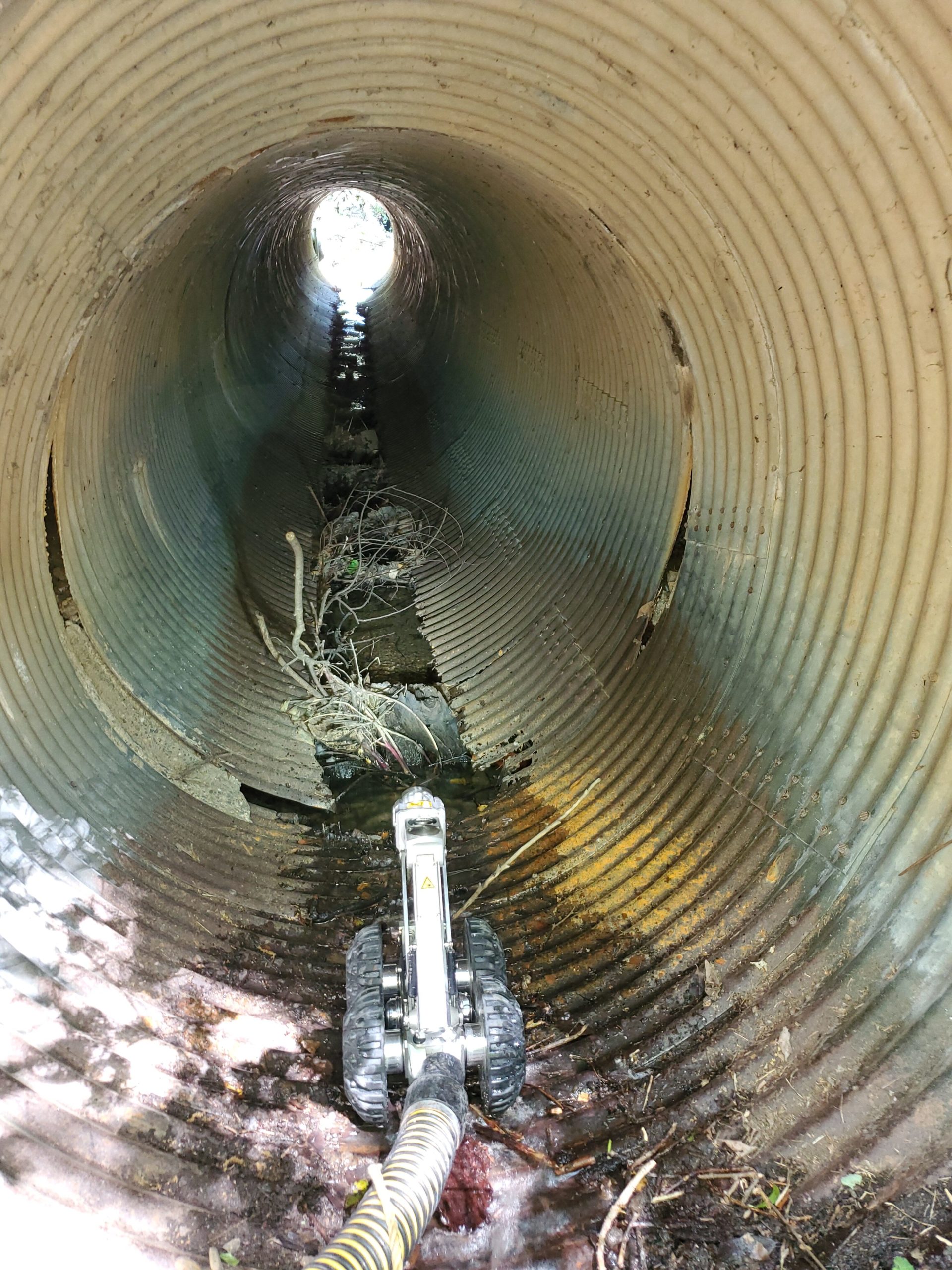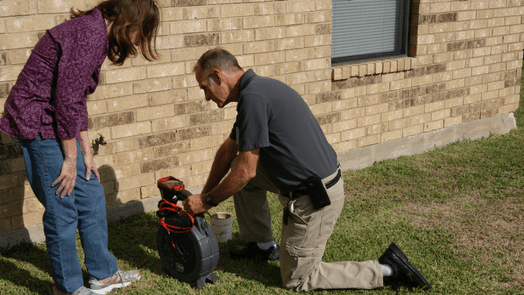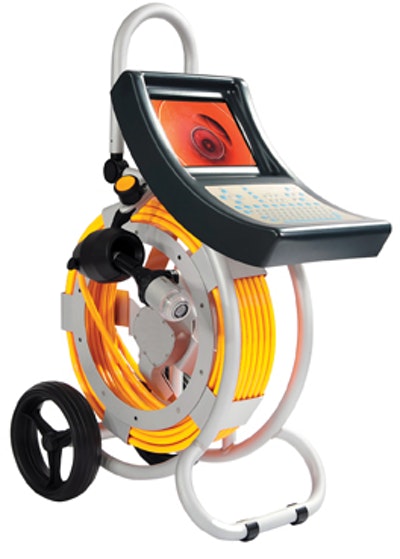Questions to Consider When Choosing a Pipe Inspection System
Pipe Inspection and location systems represent a significant investment for most small businesses. In return, they offer unique diagnostic and marketing potential that can either save or earn a tremendous amount of money for your company. Choosing the right system for your needs is a task that should be taken with serious attention to detail in order to avoid a costly mistake
What size pipes/drains/sewers are you likely to be inspecting?
The great divide in pipe inspection systems is between push rod and tractor pull style systems. Which style do you need? Tractor pull systems are generally for large, municipal style drain pipes (10 inch and larger) and pull themselves down the line. They tend to be controlled with a joystick and computer system by an operator sitting in a specially made truck or van. Prices begin in the high 30 thousands and go up from there. They are outfitted with additional lighting and swivel heads to look left, right, up and down. They are usually purchased by municipalities and larger companies.
Micro-systems, designed for 1 1/2 to 3-inch pipes. Due to the flexibility required for this size pipe, these push rods are very thin and weak. (Keep in mind that there is an inverse relationship between strength and flexibility.) If used in larger pipes, the probability of damage to the structure of the push rod is very high. They seldom have a built-in locator beacon, and may or may not have a built-in recording device.
Mini-systems, designed for 2 to 4-inch pipes. These systems are used for indoor work in the small and medium-sized pipes that connect bathrooms, sinks and toilets within a building. The push rod used in these units is stronger and less flexible than a micro unit, but the emphasis is still on flexibility, not strength. If used in larger pipes, these systems are at greater risk of kinking and damage. They usually have built-in locator beacons and often have the option of a built-in recording system.
Main line systems, designed for 3 to 12-inch lines. These systems are designed for use in outdoor pipes. While flexible enough to negotiate a house trap, the emphasis is on strength rather than flexibility. These systems generally have the same features as Mini-Systems.

Your Ultimate Guide to Choosing the Right Pipeline Inspection Services
The Environmental Protection Agency (EPA) estimates an average of 24,500 sewer overflows occur every year in the United States. Choosing the right pipeline inspection services may help prevent overflows in your city. It can also save you money by helping you keep a small problem from becoming a large one
Pipeline Size
The size of your pipelines plays an important role in finding the right inspection service. Sizes can vary from wide or narrow depending on your area’s system.
Certifications
When it comes to hiring pipeline inspection services, certifications matters. Certification is valid proof that a company went through a process to meet specific standards.
Types of Services
Choosing an inspection service that can perform several types of services will help you save time searching for different companies to cover various types of inspections.
Manhole Video inspection
The lifespan of manhole systems will depend on how often you inspect them and how well you maintain them. Environmental factors such as root trees, storms, and even earthquakes can damage the infrastructure.

Why Every Home Buyer Should Get a Sewer Inspection
Inspections are par for the course when buying a home, but there’s one important system that many potential buyers overlook: the sewer line
A typical home inspection doesn’t examine the sewer because it is buried underground. The only surefire way to have the system inspected is to hire someone to perform a sewer camera inspection. The cost of this inspection is worth it.
Imagine buying a home and finding out weeks later that there are problems with the sewer system. You’re dealing with messy backups in your home, and now you have to repair the problem.
Sewer repair is not cheap. On average, repairs can cost $5,000. If the problem is in the street, repairs can easily creep up to $20,000 or more.
Don’t assume that a newer home won’t have sewer issues. In one horror story, buyers purchased a home built in 2006. The builder decided it would be a good idea to reuse the clay sewer line from the early 1900s to save on costs. An inspection found that the line had several breaks that needed repair, despite the home being almost new.

Sewer Camera Inspection: What It Can and Can’t Find
A sewer camera is a valuable tool to help determine if there’s a problem with your home’s sewer system. Maybe you noticed a nasty sewer gas odor. Or maybe your water isn’t draining as fast as it use to. Or worse, you’ve got an overflowing toilet
What is a Sewer Camera Inspection?
First, let’s cover what a sewer camera inspection is. Typically sewer lines are installed under the foundation of your house. There’s the concrete slab which is about 4 or 5 five inches thick and then about 2 feet or so of dirt above the pipe.
What a Sewer Camera Inspection Can’t Do
Despite what many in the plumbing industry think, there are limitations to what a sewer camera sees inside your sewer lines. But there is one thing a sewer camera absolutely cannot see.
Locate Leaks
A sewer camera alone cannot determine if you have a leak or to locate a leak or leaks in your sewer lines. In fact, this is so important, it bears repeating
Reasons Why a Sewer Camera Can’t Locate a Leak
A leak is water escaping the pipe through a hole, break, or crack. Since the camera is inside the pipe, it cannot see the outside of the pipe. Meaning, it can’t see if something is leaking OUT of the pipe. It can only show what is going on INSIDE the pipe.
The plumber is looking at a monitor displaying what the camera “sees.” So the plumber has to interpret, or guess, what he’s seeing. He might think he see something that looks like a hole, break, or crack in the pipe. But keep in mind, this is your sewer system we’re talking about. This is where your waste flushes and runs through. Trust us when we say it does not look good. And all that gunk and waste makes it hard to tell if something is a leak based solely on what can be seen on the monitor.
Sewer pipes are usually one of two types: cast iron or PVC, both thick-walled pipes. So something very possibly might look like a hole or a crack or a break. But because the walls of the pipe are so thick, it’s possible what the plumber is seeing does not go all the way through the pipe so no water is leaking out at all. The result: no leak.
Particularly with cast iron, but this could also be true for PVC, there are years of buildup on the walls of the pipe. Calcium, soap scum, grease, debris… you name it, builds up on the walls of your sewer pipes. So any cracks or holes the plumber sees could very well be in the buildup and not the actual pipe.
Choosing the Best Inspection Camera for Your Business
Inspection cameras are one of the most valuable tools for any drain cleaner. Whether you’re checking a line to diagnose a problem before beginning a job or you need to locate a blockage to determine how to clear the line, the inspection camera is a must-have.
“The typical use for your everyday plumber for an inspection camera is to locate a blockage or a break in the line,” says Justin King, vice president at Amazing Machinery Inc. “They want to see the condition of the pipe, understanding if any service or repairs are needed to that line.”
Features and size
Cameras today offer a wide range of features and benefits to meet the demands of all types and sizes of pipelines. While some units may fit the needs of a large municipality with a regular inspection schedule and hundreds or thousands of miles of pipeline to maintain, it may not be suitable for a small drain cleaning company.
One such option is the easy-to-use Pan n’ Tilt push camera from Ratech Electronics. It is designed for pipes and drains as small as 3 inches in diameter and offers black-and-white, color, self-leveling, micro and pan n’ tilt camera options.
More advanced inspection camera systems include network communications options such as Wi-Fi to transmit to a nearby computer. King notes the Wi-Fi feature is a great option for municipal applications, but a private contractor may not need it. “They’ll want the basic system, a get-your-job-done kind of camera, that’s where you’re going to find more of your affordable types of cameras that private companies can afford to invest in.”